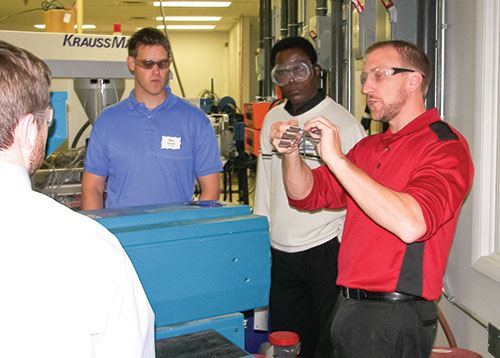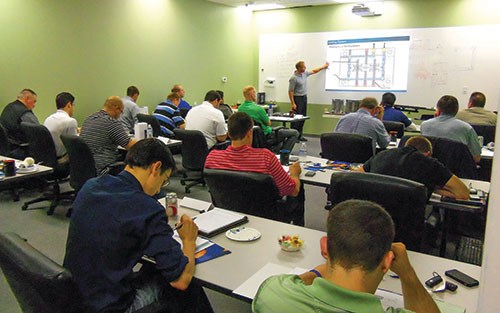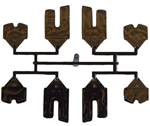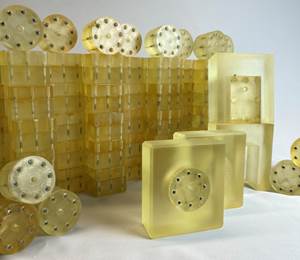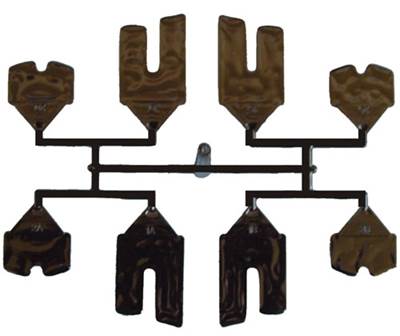Training Initiative’s "Mold VS Machine" Approach Boosts Moldmaker/Molder Relationship
“Understanding mold design helps molders understand the limitations as well as the possibilities in mold design. Molders can ask constructive and critical questions with knowledge, and also conjure recommendations and make suggestions for improving designs.”
Thogus (Avon Lake, OH)—a 62-year-old custom injection molding company that serves the healthcare, aerospace, small household appliances, consumer, industrial, telecommunications and plumbing markets—recently partnered with Erie, PA-based Beaumont Technologies Inc. to send nine of its employees to the “Mold Design for Project Engineers Course” to learn about key plastic principles, including plastic flow, types of melt delivery systems, how to size up a mold for a given molding machine, mold cooling design strategies, and common mold design pitfalls, among other topics.
Thogus President Matt Hlavin is a proponent of creating partnerships with everyone who touches the company’s supply chain. “We are not just your ship and shoot molder,” Hlavin notes. “We have the expertise and technology to work with our clients from product development to prototyping all the way through production. Being engaged in the forefront of change is critical for our success. In doing so, we must push forward with continued plastics education. Just like physicians who must remain in front of medical breakthroughs, we must do the same with our engineers and program managers in this new industrial revolution.”
Technical Training
Enter Beaumont Technologies, a company that was originally founded in 1998 to commercialize a new plastic melt conditioning technology called MeltFlipper® that was invented and developed by John Beaumont. The company also committed to educating the plastics industry about the importance of education, and has since added additional products and services—including consulting services and plastics training (see MoldMaking Technology December 2012, page 26).
David Hoffman, Beaumont’s Senior Instructor & Training Development Manager, points out that “Mold Design for Project Engineers” was designed as a direct result of industry feedback. “A molder near Pittsburgh, PA called and asked if we had a course that taught the basics of mold design,” Hoffman recalls. “He saw a need within his company, stating that ‘I have several project engineers going out to review and approve molds, and often they are not sure what they are looking at on mold prints nor do they know the right questions to ask to ensure the mold design meets basic requirements.’”
Hoffman and his colleagues used these comments as the building blocks for the course, starting with a basic understanding of what plastics are and how they flow inside of a mold. “This is important for mold designers to understand so they can improve weld-line strength, minimize flow hesitation effects, and reduce part warp by properly selecting a gate location(s), for example,” he states. “The course then progresses into injection molding fundamentals—all with the purpose of building toward an understanding of the mold and its role in part quality. We talk about numerous aspects of the mold but spend a bit more time on a few key systems, such as the ejection system, cooling system, and melt delivery system.”
Hoffman then takes the "mold versus machine" approach and discusses the many variables to evaluate to ensure the mold is capable of running in a given molding machine. “One particular topic that gets people thinking is clamp tonnage,” Hoffman comments. “There are many rules of thumb for estimating clamp tonnage in our industry. In this class, we evaluate four different methods for estimating the required clamp tonnage for a given part—while evaluating two different grades of a material—and come up with six different answers.”
The course concludes with a section discussing common mold design details that are easily overlooked or misunderstood, but can create a world of headaches from the processing, part quality, and troubleshooting aspects, Hoffman adds.
Initially, the course was developed with project engineers in mind, but Hoffman notes others are interested—including marketing personnel, sales people, purchasing managers, etc. “These people don't necessarily need to know the intricacies of designing an unscrewing mold or stack mold, but they have a desire to do their jobs better and this includes a need to communicate more effectively with their peers and mold builders,” he states. “For example, a purchasing manager who is responsible for buying molds will be more knowledgeable about questions to ask a prospective mold designer/builder about their practices on cooling layouts, ejection and melt delivery systems to ensure the mold performs as needed in the cycle time quoted without excessive waste and without compromising the part quality and profitability of a project. As for the sales personnel, they will be able to better understand and communicate (and sell) what it is their company does when they are in front of prospective clients who may not be very familiar with the mold building or injection molding processes. Having a sales person who is technically knowledgeable about the services they are selling earns trust (and business) from the client.”
Thogus Engineering Manager James Michalenko is in complete agreement. “Knowledge is power,” he affirms. “Understanding mold design helps molders understand the limitations as well as the possibilities in mold design. Molders can ask constructive and critical questions with knowledge, and also conjure recommendations and make suggestions for improving designs. Another important aspect is that if molders are responsible for the customers’ tool design and approval, they should have knowledge to evaluate mold designs and approve them for the customer—which is the case for us most often than not.”
Real Results
Michalenko notes that Thogus considers training paramount to maintaining the highest molding quality. “Our employees seek training that expands their knowledge and that they feel they will be able to apply immediately, once they complete the training,” he states. “Their goal is to strengthen their expertise, raise their level of impact within the company, and bring value to themselves and what they can offer the company as a critical tool.”
Thogus Business Development Manager Russ Wolff found that what he learned from the training can be applied both internally at Thogus and externally with the company’s customer base. “It has helped me communicate better with our program managers and engineers with respect to part requirements,” Wolff says. “I found the section on molds—specifically Mold Component Terminology, SPI Mold Classifications, Mold Material Classifications, Draft and Parting Line Considerations and Ejection Systems—to be very interesting. The mold versus. Machine section was also very useful, especially with the discussions surrounding clamp tonnage requirement; mold dimensions with respect to open and close heights; and injection rates and pressures.”
Brad Krupa, Program Manager of Strategic Accounts at Thogus, notes that he is now able to contribute more advising tool drawing reviews based on what he learned at Beaumont’s training course. “Learning how plastic material moves and flows through a mold has changed the way I am going to approach plastic molding,” he comments.
Beaumont’s Hoffman believes educating molders on the basics of mold design will ultimately improve the moldmaker/molder relationship. “Both have a common goal of providing a product that meets the needs of their respective clients,” he states. “If the molder is better able to specify what it is they need in terms of part requirements, understand why the designer did or did not do something in the design, and also offer ideas along the way—then this will only help both parties achieve that common goal.”
For More Information
Thogus Products / (440) 933-8850
dfoster@thogus.com / thogus.com
Related Content
Laser Welder Yields Fast, Precise Mold Repair
Intralox's integration of the Alpha Laser ALFlak has significantly improved their tool room efficiency when it comes to difficult welds and urgent repairs.
Read MoreIn "Hybrid" FIM Process, 3D Printing Complements Injection Molding
Alpine Advanced Materials used a desktop 3D printer and the freeform injection molding process to reduce prototype tooling production time and cost for its customers.
Read MoreFive-Axis Vertical Mill Increases Mold Shop Capacity by Reducing Setups
Zero Tolerance now processes blocks — from squaring to waterline drilling to rough and finish milling — on a single five-axis CNC mill, reducing setups and moving blocks in/out of multiple machines without sacrificing accuracy and surface finish.
Read MoreHow to Clean and Maintain Molds With Intricate Conformal Cooling Channels
A water-based, eco-friendly plastic mold cleaning system helps Rankine-Hinman Manufacturing restore flow rates and avoid big-ticket failures on complex and costly molds.
Read MoreRead Next
The Real Cause of Multi-Cavity Mold Imbalances
A lesson on shear induced melt variations ends some confusion regarding balancing runner systems for multi-cavity molds.
Read MoreReasons to Use Fiber Lasers for Mold Cleaning
Fiber lasers offer a simplicity, speed, control and portability, minimizing mold cleaning risks.
Read MoreAre You a Moldmaker Considering 3D Printing? Consider the 3D Printing Workshop at NPE2024
Presentations will cover 3D printing for mold tooling, material innovation, product development, bridge production and full-scale, high-volume additive manufacturing.
Read More
